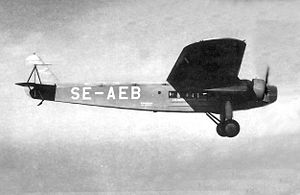Fokker F.VIII Video - Picture

|
|
Fokker F.VIII
F.VIII

Picture - Fokker F.VIII "Jx¤mtland" of Swedish airline ABA, showing the Pratt & Whitney engine installation.
Role: Airliner
Manufacturer: Fokker
Designed by: Reinhold Platz
First flight: 12 March 1927
Primary users: KLM
Malert
Number built: 11
Developed from: Fokker F.VII
The Fokker F.VIII (or F.8) was a large twin-engined airliner designed and produced by the Dutch aircraft manufacturer Fokker in the 1920s.
Design and development
In 1926, the Dutch airline KLM issued a request for an airliner with more passenger capacity than the F.VII variants in operation at the time. Designer Reinhold Platz immediately started work on the F.VIII in response.
The F.VIII featured mixed construction: fuselage and tail section were constructed as a frame of welded steel covered with plywood (sometimes known as multiplex), canvas and duralumin, but the wing framing was all wood covered with plywood. This had become standard Fokker construction and the result was one of their characteristic cantilever high winged monoplanes.
The F.VIII was Fokker's first twin engined airliner, a reflection of the increasing power available from the light radials engines of the time. All their previous designs had an engine in the nose, and its absence in the F.VIII lead to less prop-wash wear and tear on the fuselage and much lower vibration levels for passengers. The first aircraft used 358 kW (480 hp) Bristol Jupiter radial engines built under licence by Gnome-Rhone, strut mounted and uncowled under the wings. KLM later re-engined theirs with 391 kW (525 hp) Pratt and Whitney Wasp T1D1 radials, cowled with Townend rings and mounted further forward than the Jupiters. One aircraft, which for part of its life flew as PH-OTO was used to explore the effects of mounting engines in, rather than below the wing. There were concerns that this arrangement, which became standard in later propeller driven aircraft would seriously disturb the airflow over the upper wing. It used 589 kW (790 hp) Wright Cyclones.
The standard cabin accommodated 15 passengers seated three abreast, but KLM chose a more luxurious 12-seat arrangement, well received at the time.
The prototype made its maiden flight on March 12, 1927. 11 F.VIII aircraft were built, three under licence by Manfred Weiss in Budapest. Fokker designed, but did not build a seaplane version designated F.VIIIw.
Operational history
KLM accepted delivery of the first of their seven on June 24, 1927. They were used exclusively on the European routes. The Hungarian Malert company bought one aircraft and had another three built under licence at the WM factory, all using Gnome-Rhx´ne Jupiter 9A engines. These Budapest airliners flew on Malert's short haul routes; two were lost in crashes.
In 1936, two of KLM's Wsap-powered aircraft were sold to British Airways for use on their cross channel routes. In 1937, KLM's PH-AED was sold to Venezuela. On the eve of war in 1939, one of KLM's F.VIII's, PH-AEG, was transferred to the Swedish Air Force via ABA. Thus the airplane first flew with civil identification code SE-AEB but later on it got its Swedish Air Force designation, 916. This Fokker type was called Tp 10 in Swedish service. Another ex-KLM aircraft flew Sweden as SE-AHA (sse below).
Finnish service
The Finnish Air Force's sole Fokker F.VIII was ex-KLM Wasp-powered H-NAEI, production number 5046. KLM's West Indies division used it for regular passenger service with registration PH-AEI. In 1937, it was sold to British Airways Ltd, where it was registered as G-AEPU and used to transport passengers across the English Channel. Swedish company G.A. Flygrender purchased the aircraft in 1939, and it was ferried to Sweden via Amsterdam, Copenhagen and Torslanda on April 7, 1939. In Sweden, registered as SE-AHA the aircraft mainly flew in the Gothenburg area.
During the Winter War, the Swedish National Socialist organization Nationella Samlingen organized a national fundraising drive for Finland's anti-Bolshevik war. With money obtained, it purchased the above-mentioned F.VIII from G.A. Flygrederi, for 73,500 Swedish kronor. Thus, Swedish SE-AHA became Finnish OH-FOA and was flown to Finland on 11 November 1940. Once in the Finnish Air Force, it was given code FE-1. Due to the bad condition of its wings, it first had to be overhauled. It took until 4 August 1941 before the plane was transferred to LeLv 46. There, it was mainly used to transport wounded soldiers from the island of Lunkula. Ten flights were made before the aircraft was destroyed on 27 September 1941, due to engine failure caused by air in the fuel system. The crew escaped unharmed despite their crash-landing in the woods; they were transporting at least one seriously injured passenger at that moment.
Accidents and incidents
On 22 August 1927, H-NADU of KLM crashed near Sevenoaks, Kent following loss of the tailfin.
Operators
Civil
Netherlands
KLM
Hungary
Malert
Sweden
ABA
United Kingdom
British Airways
Military
Finland
Finnish Air Force
Sweden
Swedish Air Force - (Tp 10)
Specifications (Jupiter-engined)
Data from de Leuuw pp 64-7
General characteristics
Crew: two
Capacity: 15 passengers
Length: 16.80 m (55 ft 1.5 in)
Wingspan: 23.00 m (75 ft 5.5 in)
Height: 4.20 m (13 ft 4 in)
Wing area: 82 m² (880 ft²)
Empty weight: 3,350 kg (7,385 lb)
Max takeoff weight: 5,800 kg (12,790 lb)
Powerplant: 2x— Bristol Jupiter IV, Gnome-Rhx´ne Jupiter air-cooled radials, 360 kW (480 hp) each
Performance
Maximum speed: 140 km/h (118 mph)
Cruise speed: 117 km/h (96 mph)
Range: 700 km (435 mi)
Service ceiling: 5,500 m (18,000 ft)
Comparable aircraft
Ford Tri-Motor
de Leeuv, Fokker Commercial Aircraft, (1994). Fokker. The Hague, Haagste Drukkerij
A.J.Jackson, British Civil Aircraft 1919-1972 (1973. London: Putnam Press ISBN0 85177 9813 5
Sources
Timo Heinonen: Thulinista Hornetiin - Keski-Suomen ilmailumuseon julkaisuja 3, 1992. ISBN 951-95688-2-4
Matti Hx¤mx¤lx¤inen: Pommituslentolaivue 46, Koala-Kustannus 2005. ISBN 952-5186-61-X
www.dutch-aviation.nl. The English part of this page contains the text, though not the specs from de Leeuw.
Fokker F.VIII Pictures
More aircraft.
Source: WikiPedia